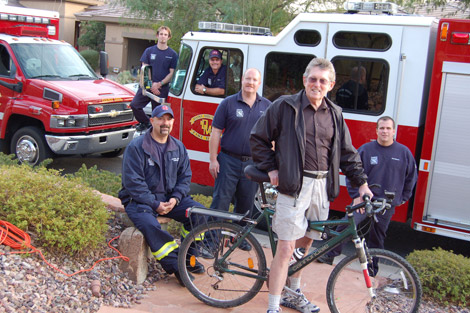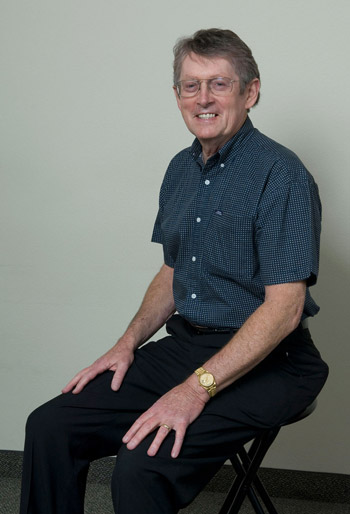Not surprisingly, Anthem resident Tom Francis has no memory of the day he died. He has no memory of the Anthem neighbors who saw him fall from his mountain bike and called 911, or of his resuscitation by Daisy Mountain firefighters.

Tom Francis meets with members of the Daisy Mountain Fire Department outside his home in Anthem.
Because he suffers from supersensitivity to cold, he’s grateful he has no memory of being bundled in icy saline packs during the race down Interstate 17 to John C. Lincoln Deer Valley Hospital or being wrapped in high-tech hypothermia blankets in the Intensive Care Unit.
But, mostly, Tom Francis, 67, is grateful to the members of the Daisy Mountain Fire Department and the medical team at the Deer Valley Hospital whose partnership made his survival possible. Pat Francis, Tom’s wife, is equally grateful and enthusiastic about the extraordinary care her husband received.
According to Pat, who does remember everything about that scary week in early November 2009, the 8th was an ordinary Sunday. They went to church, had lunch in a local restaurant and visited a community art show down the road in Carefree. After they got home, Tom, a fitness buff, decided to take a bike ride out into the desert.
“I was lucky,” he said, “that my heart attack happened when it did and not 10 minutes later. I figure I was dead when I hit the ground. If I’d been out in the desert, there wouldn’t have been neighbors standing nearby to call for help.”
Francis also was lucky because Daisy Mountain and the Deer Valley Emergency Department have installed technology and developed systems to provide heart attack patients from Anthem and other North Valley communities with extra lifesaving time. Thanks to new technology installed in Daisy Mountain’s eight emergency response vehicles, crews can push a button to send patients’ electrocardiogram (EKG) results via wireless Bluetooth to the Deer Valley ED, the North Valley’s first Chest Pain Center accredited to provide the highest level of cardiac care.
It takes 20 to 45 minutes to travel from Anthem, New River and other parts of the far North Valley to the Deer Valley Hospital, the nearest full-service medical facility. Before the new systems were installed last year, patients could not be diagnosed until they actually reached the ED, and only then could the decision be made to mobilize a cardiac treatment team. That added another 20 to 45 minutes to the time required to treat heart attack patients.
Now, while the ambulance is en route, doctors in the ED can evaluate the EKG results to determine whether the patient is having a heart attack. If so, the treatment team is immediately mobilized so they’ll be waiting when the patient arrives. Having the cardiac catherization lab team ready to go cuts valuable minutes from treatment time.
“That’s significant,” said Emergency Physician Jonathan Maitem, DO, the Prehospital medical director for the Deer Valley ED, “because while heart muscle is dying, every minute counts. The national standard for restoring blood flow after heart attack patients arrive at the hospital is 90 minutes. We now have our systems refined so that we’ve restored blood flow in as little as a half an hour.”
“It’s really a pretty cool system,” said Daisy Mountain paramedic Dave Hamilton, who led the fire department’s effort to get the Phillips MRx 12-lead EKG technology and monitors installed in emergency rescue vehicles and to train all emergency medical technicians and paramedics in sending EKG results wirelessly to the Deer Valley ED.
The ED physician receives additional information from Daisy Mountain EMTs via the ambulance Bluetooth radiophone. “This is important so our medical team has information about any other issues, such as patient injuries or other disease,” Dr. Maitem said.

New technology and a partnership between Daisy Mountain Fire Department and John C. Lincoln Deer Valley Hospital helped save Tom Francis’ life.
Daisy Mountain answers more than 3,000 emergency calls a year and transports about 50 percent of these patients to area hospitals. Approximately one-fourth of the patients transported were brought to hospital emergency departments with some type of chest pain.
During 2009, 10 patients were saved with the assistance of the partnership between Deer Valley and Daisy Mountain, according to District Fire Marshal Phil Dyer. The system was developed to speed restoration of blood flow by cutting time required to implant cardiac stents in the hospital’s cath lab. It also works to the benefit of cardiac arrest patients who need hypothermia.
“When the heart stops beating, fresh oxygen is no longer delivered in the bloodstream to the brain and other vital organs,” explained cardiologist Tri Nguyen, MD, medical director for Non-Invasive Cardiology Services at Deer Valley. “At normal temperatures, tissue deprived of fresh blood begins to die fairly quickly.”
Hypothermia, or cooling the core body temperature to 89 - 95 degrees Fahrenheit, has been shown to help keep the brain stable and to improve neurological recovery. Because it slows metabolism and reduces the body’s demand for fresh oxygen, it gives the body a much-needed window of time to recover in a less stressful environment, Dr. Nguyen said. After evaluating Francis, hospitalist Maria Soriano, MD, was convinced that hypothermia was essential for his recovery.
“Dr. Soriano was very caring, but she was also specific,” Pat Francis said. “She told us that chances of full recovery were not guaranteed and that it would be a good idea to call family members who wanted to see Tom.”
Tom’s brother, Bob Francis, MD, an orthopedic surgeon in North Carolina, jumped on a Phoenix-bound plane and “was terrific,” Pat Francis said. “He helped me understand everything that was happening.”
As a poster child for the process, Tom Francis does remember a slow return to consciousness in the hospital’s ICU after hypothermia was successful in both protecting and preserving his brain.
“It happened in bits and pieces over several days,” he said. “I remember being full of tubes and pipes. Over the following days, they shuffled me around in a wheelchair, but eventually I was able to get up and start walking. It’s been steady improvement ever since.”
“The doctors, the nurses, the staff were all so pleasant,” Pat Francis said. “We were so happy with the care Tom got.”
Now, to the amazement of the firefighters who first resuscitated him and the medical personnel at the hospital who provided the rest of his care, Tom is back to full strength mentally and only a few rehabilitative steps away from bike riding in the desert.
“I’m ready,” he said.
Visit JCL.com/heart for more information about our cardiac services and programs.